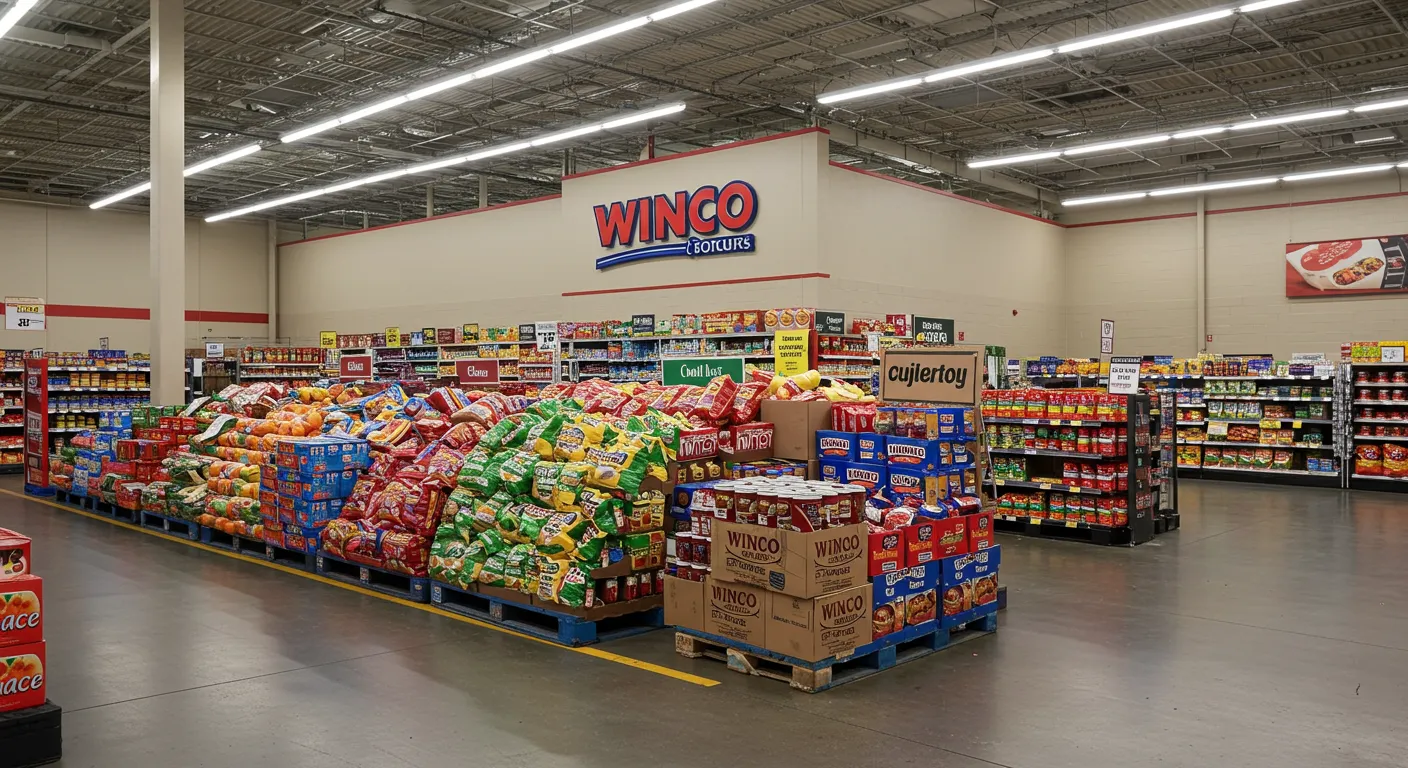Table of Contents
If you’re a regular shopper at Winco, you may have noticed something: your grocery bill is often lower than it would be at other supermarkets. But have you ever stopped to wonder why Winco is cheaper than competitors? How does it manage to keep prices so low while still offering a wide selection of products?
This blog post will take a deep dive into the unique factors that make Winco stand out in the crowded world of grocery retailers. We’ll explore its business model, operational strategies, and the tactics it uses to pass savings onto its customers. By the end, you’ll have a clearer understanding of what sets Winco apart—and why its prices remain some of the most competitive in the market.
The Price Puzzle: Winco vs. Its Competitors
A Quick Overview of Winco
Before we jump into the details, let’s first take a look at what makes Winco unique. Founded in 1967, Winco Foods is a regional discount grocery chain with locations primarily in the western U.S. What makes Winco stand out is its focus on providing quality products at budget-friendly prices.
Unlike traditional grocery stores, Winco has built a reputation for its low-cost approach. It’s a no-frills, warehouse-style store that often offers bulk buying options, which helps reduce prices for consumers. But these low prices aren’t just because of bulk purchasing; Winco’s business model and operational strategies play a huge role.
Comparing Winco to Major Competitors
When we compare Winco to other popular grocery chains—such as Walmart, Safeway, Costco, or Albertsons—it’s clear that Winco’s pricing strategy is different. Winco often outperforms these stores in terms of sheer affordability, especially for everyday items like fresh produce, dry goods, and dairy.
Here’s a quick breakdown of how Winco stacks up:
| Category | Winco | Walmart | Costco | Albertsons |
|---|---|---|---|---|
| Price Range | Very Low | Low | Medium | High |
| Bulk Purchases | Extensive | Limited | Extensive | Limited |
| Product Variety | Moderate | High | High | Very High |
| Store Format | Warehouse | Superstore | Warehouse | Supermarket |
As you can see, Winco tends to provide the best prices for everyday grocery items, and it competes closely with Costco in terms of bulk purchasing. But what gives Winco the edge over Walmart and Albertsons? Let’s take a closer look.
1. The Warehouse Model: Low Overhead, Low Prices
One of the key reasons why Winco is cheaper than competitors is its warehouse-style store layout. The majority of Winco locations are designed to operate with minimal overhead costs. By adopting a simple, no-frills approach to store design, the chain is able to keep operating expenses low and pass those savings directly onto customers.
This model contrasts sharply with supermarkets like Safeway and Albertsons, which often invest heavily in store aesthetics, customer service, and high-end marketing. These additional costs are reflected in higher prices for the consumer. Why is Winco so cheap, on the other hand, focuses on efficiency and affordability, prioritizing savings over luxury.
Key Benefits of the Warehouse Model:
- Lower Rent and Utilities: With fewer investments in store decor, Winco can save a significant amount on rent and utilities.
- Smaller Staff: Since Winco’s stores don’t have elaborate displays or high-touch customer service, they often require fewer employees.
- Reduced Packaging Costs: In many Winco stores, products are displayed in bulk bins or minimal packaging, which helps reduce costs.
The result is that Winco can pass these savings on to its customers in the form of lower prices.
2. Private Label Products: High Quality, Low Price
Another reason Winco’s prices are consistently lower is its extensive use of private-label products. Private labels are products manufactured by a third party but sold under a store’s brand name. These products often come with significant savings because the retailer avoids the costs associated with national branding and marketing.
Winco’s private label, Winco Brand, offers everything from canned goods to fresh produce at a fraction of the cost of national brands. Despite being cheaper, these private-label products maintain high quality, which is why many loyal Winco shoppers swear by them.
Advantages of Private Labels:
- Lower Manufacturing Costs: Since Winco controls the branding and often works with third-party manufacturers, costs are kept low.
- Higher Margins: By selling private-label products, Winco can earn a higher profit margin compared to selling national brands, allowing for further price reductions.
- Consistency in Quality: Winco ensures that its private-label products meet high-quality standards, making it a trusted option for shoppers seeking both value and reliability.
This strategy not only helps Winco cut costs, but it also allows the company to offer competitive prices without sacrificing product quality.
3. Bulk Purchasing and Limited Selection
Bulk purchasing is another critical component of Winco’s pricing model. Bulk buying reduces unit costs, allowing Winco to offer lower prices on common household items. Shoppers who are willing to buy in larger quantities can save even more money.
However, there’s a trade-off: Winco’s stores offer a more limited selection compared to larger chains like Walmart or Costco. Instead of offering every brand and variation of a product, Winco focuses on the essentials and high-demand items, which helps keep prices down.
While this may not appeal to all shoppers, the majority of customers who are looking for everyday groceries will find everything they need at a lower price point.
Key Bulk Benefits:
- Lower Unit Prices: Buying in bulk helps Winco negotiate better deals with suppliers and pass those savings on to customers.
- Fewer SKUs: With fewer product options, Winco can streamline inventory and reduce waste, ultimately lowering costs.
- Value for Money: Customers can purchase large quantities of items they use regularly, stretching their grocery budget even further.
4. Minimal Marketing and Advertising Costs
Unlike larger chains that invest heavily in advertising and marketing campaigns, Winco spends very little on these areas. Most of Winco’s marketing happens through word of mouth, customer referrals, and in-store promotions. This is another strategic choice that allows Winco to keep its prices low.
By eliminating large-scale advertising campaigns, Winco avoids passing those additional costs onto the consumer. This is in stark contrast to brands like Safeway or Albertsons, which rely heavily on TV ads, flyers, and digital marketing strategies to attract customers.
How Marketing Affects Prices:
- No Expensive TV Commercials: Winco avoids the costs of traditional marketing channels.
- In-House Promotions: Winco’s promotions are usually low-cost and direct, such as in-store signage or simple loyalty programs.
- Word of Mouth: A large portion of Winco’s customer base comes from recommendations, helping to keep costs down.
5. Employee Ownership: A Key to Efficiency and Savings
One of the most unique aspects of Winco is its employee-ownership model. Winco is partially owned by its employees through an Employee Stock Ownership Plan (ESOP). This model fosters a sense of ownership and accountability, which translates into a more motivated and efficient workforce.
By aligning the interests of employees with those of the company, Winco reduces turnover and improves efficiency. A more efficient workforce means fewer costs for the company, and again, these savings are passed on to customers.
Benefits of Employee Ownership:
- Increased Productivity: Employees are more likely to work efficiently when they have a stake in the company’s success.
- Lower Labor Costs: With lower turnover rates and better employee retention, Winco saves on recruitment and training costs.
- Stronger Customer Service: Employee owners take pride in their work, leading to better service and overall customer satisfaction. Click here read more articles.
Final Thoughts: Winco’s Unique Strategy for Saving You Money
So, why is Winco cheaper than competitors? It’s a combination of several well-thought-out strategies that all focus on one goal: keeping costs low for consumers. From its warehouse-style stores to bulk purchasing and private-label products, Winco has crafted a model that delivers quality and savings in a way that many competitors cannot match.
If you’re looking for great value without sacrificing quality, Winco’s no-frills approach offers a refreshing alternative to pricier grocery stores. By reducing overhead, limiting marketing costs, and offering bulk options, Winco proves that grocery shopping doesn’t have to break the bank.
So next time you’re at Winco, take a moment to appreciate the behind-the-scenes strategies that help keep those prices so low. Whether you’re stocking up on pantry essentials or grabbing fresh produce, Winco’s commitment to affordability ensures you’re getting the best deal around.





